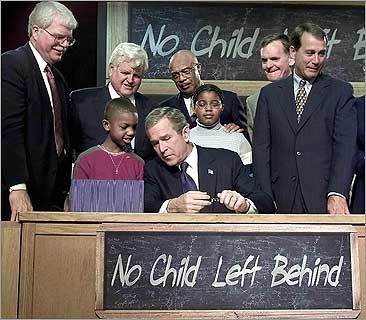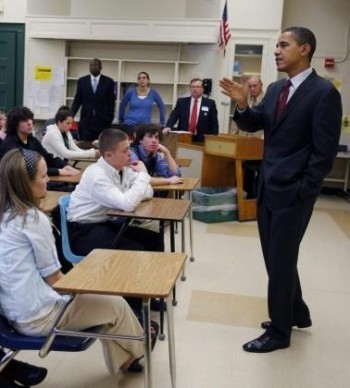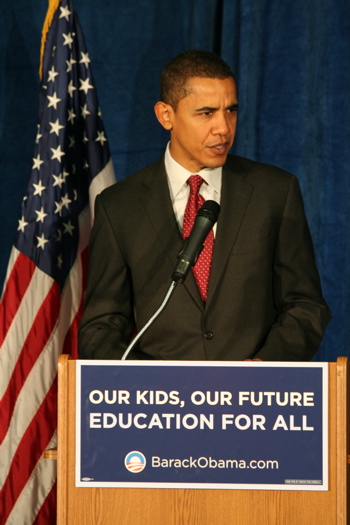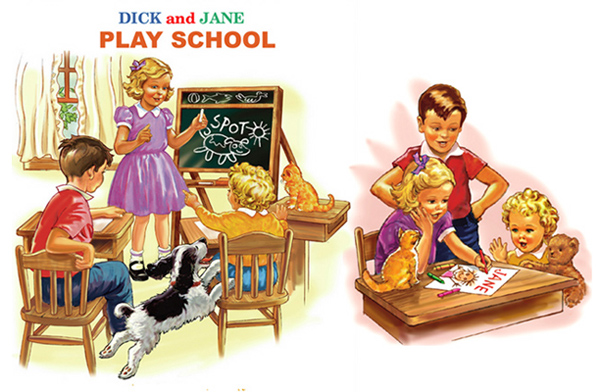The Challenge: Education
 The No Child Left Behind Act put into effect by the George W. Bush administration in order to address the challenge of educating minorities has brought about diverse results during its years of application. While secondary education results are inconclusive, with the breach in academic achievement between Hispanics and whites being reduced, increased and unchanged in an equal ratio across states, in primary education the results have been more positive; the NCLB initiative has been able to close the gap in academic achievement between Hispanics and whites in almost all states.
The No Child Left Behind Act put into effect by the George W. Bush administration in order to address the challenge of educating minorities has brought about diverse results during its years of application. While secondary education results are inconclusive, with the breach in academic achievement between Hispanics and whites being reduced, increased and unchanged in an equal ratio across states, in primary education the results have been more positive; the NCLB initiative has been able to close the gap in academic achievement between Hispanics and whites in almost all states.
This initiative to integrate Hispanics into the educational system must continue and must be done correctly. This is the challenge that state and federal authorities face. Some solutions attempt to strengthen standards of quality and excellence that would permit us to ascertain if students are really learning at school, to evaluate and educate students in more rigorous and demanding ways, and decentralize the educational system. In the same way, we must also establish standards of quality for teachers in order to discover if they are effective in the classroom, if they are capable, if they are motivated, if they make progress with students, if they are adequately rewarded for their successes, etc.


As we are well aware, and as is demonstrated by studies realized at the national level, a good teacher in front of a student during 3+ years makes a huge difference, generally raising the child’s test scores 20 points.
A large majority of states are currently contemplating a series of standards that measure the effectiveness of teachers.
Strengthening the idea of English language skills and fluency as tools of academic success is vital. Fluent command of the English language permits the full integration of Hispanic students, and allows them to select and complete necessary coursework for University admission. We know that 50% of Hispanic students graduate from high school but only 20% are prepared for University, demonstrating the necessity of clearly defining what students should learn in secondary school in order to attend University afterwards.



Additionally, the active participation of parents in the education of their children is an essential factor in the academic success of Hispanics and can contribute to families’ full integration into their communities
Education in this country must continue to be the key to success for citizens. To achieve this success, Hispanics must actively participate in the educational system, demanding improvements and responding to the system’s challenges. It’s time for a shared effort that permits improvements in education and access to opportunities for Hispanics in this country
According to the Census, a fourth of those enrolled in kindergarten in the United States, made up of minors between 3 to 6 years old, are Hispanics. This puts into stark relief an accelerated tendency that points to minority infants becoming the majority in 2023. Hispanics represent almost a fifth of all students in the K-12 sector (from kindergarten to 12th grade, the majority of schools in the U.S. have 12 grades).
It’s evident that the continued growth of the Hispanic population along with its effect on the nation’s youth population, will influence the political debate over education, employment and immigration during years to come. Offering answers tailored to meet the needs of this population and guarantee its success, is a priority; the conservative movement can provide these answers to these communities.
Ethnic changes in school enrollment are more evident in states like Arizona, California, and Nevada, which are seeing a greater influx of Hispanics due to immigration and a higher birth rate in respect to other ethnic groups.



The Hispanic presence in society and in the educational system will continue to grow. In the politics of education, it will be necessary to find effective solutions, for education can and should be a tool towards development, integration and motivation for Hispanics in the United States
Achieving this will require the reinforcement of objectives that pursue educational excellence, parent participation, academic achievements and preparation, assessment, the commitment of social and business communities, and responsibility for University admission.
If they truly desire to improve basic and university education for Hispanics, state and federal authorities must be attentive to the needs presented in school communities around the country, but must also be stronger leaders in private initiatives that permit increased educational pluralism.

The Dream Act and the No Child Left Behind Act were put into effect to help Hispanics achieve academic success, but they must not be the only measures taken; we cannot leave everything in the hands of the government.
Today, as always, education, along with the initiatives that make it possible and bring us all closer together, are part of the American Dream.
Discursos Presidenciales a los Estudiantes sobre Educación
Pres. Obama National Address to Students
Ronald Reagan speech to students 1
Ronald Reagan speech to students 2
Ronald Reagan speech to students 3
Ronald Reagan speech to students 4
George H.W. Bush 41 pitches education plan in televised classroom speech








